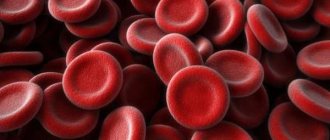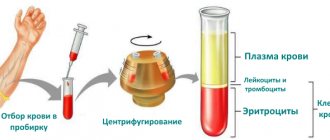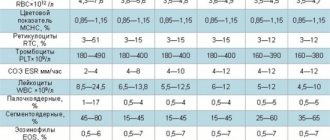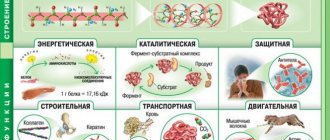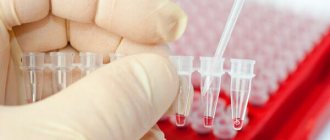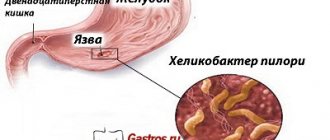What is an INR blood test?
INR is not an actual value and is calculated using mathematical equations.
The basis is the PT value (prothrombin time), the normal value of which is considered to be 11-16 seconds, and the thromboplastin sensitivity index (TSI), which is the active developing reagent. The result of the INR readings can be presented as a mathematical formula (INR = PVMICH). In most cases, such an analysis is prescribed to people taking anticoagulants who need constant and timely monitoring of blood clotting. As a result of such an analysis and correct calculation, specialists are able to obtain an accurate idea of the level of plasma in the blood, excluding errors and any external factors. Regardless of which laboratory the blood test was performed in, the results will be valid in medical institutions around the world and will be identical when deciphered. Such a blood test will allow specialists to select the required amount of anticoagulants and fully control the treatment process.
Interpretation of a blood test for INR
INR values will primarily depend on the activity of coagulation factors (specific blood proteins), which are formed in the liver and represent “targets” for the action of anticoagulants (for example, Dabigatran, Warfarin). Therefore, if a patient uses anticoagulants, he should periodically take a blood test for INR.
Experts identify certain indications for prescribing a blood test for INR, and the norms for this characteristic will differ in different cases.
- Examination of the patient before surgery. Normally, the INR ranges from 0.85 to 1.25.
- Warfarin therapy for chronic atrial fibrillation. The INR norm is 2.0-3.0.
- Treatment of pulmonary embolism. The normal INR is from 2.0 to 3.0.
- For some heart valve defects, the normal blood test for INR is between 2.0 and 3.0.
- When treating venous thrombosis, the normal INR value is 2.0-3.0.
- For vascular diseases, this figure is 3.0-4.5.
Going beyond these indicators is extremely undesirable, and in some cases even dangerous. An increase in INR when taking Warfarin and its analogues indicates a decrease in coagulation, which is fraught with various bleedings: both external and internal (gastric, abdominal, uterine).
If INR values exceed the upper limits of normal, treatment requires a reduction in the dose of indirect anticoagulants, and if its values are too low, it suggests an increase in the dosage of these drugs due to the ineffectiveness of treatment.
According to the transcript of this study, an INR value above 1.25 (in patients not taking anticoagulants) is extremely dangerous due to the risk of developing a number of pathologies, in particular:
- congenital diseases of the blood coagulation system;
- liver diseases;
- disorders of lipid absorption in the intestine;
- problems with the passage of bile from the liver into the duodenum;
- myocardial infarction;
- pre-infarction condition;
- malignant tumors;
- polycythemia;
- hemorrhagic disease in newborns.
If a patient's INR value exceeds 6 units, he requires urgent hospitalization due to a significant risk of bleeding of various locations. This condition is extremely dangerous if the patient has certain concomitant diseases: inflammatory or peptic ulcers of the stomach and intestines, kidney pathologies, arterial hypertension.
A decrease in the INR level in a blood test indicates the following pathologies and conditions:
- vitamin K deficiency in the body;
- congenital or acquired prothrombin deficiency;
- massive entry into the bloodstream of tissue thromboplastin during injury or necrosis;
- increased blood clotting during pregnancy or after childbirth.
INR norm when taking warfarin
Determining the INR level is a mandatory procedure for patients taking a special drug to slow down the blood clotting process (warfarin) due to the fact that their body is prone to increased formation of blood clots. These patients have their own INR standards.
First, let's figure out what kind of drug this is. Warfarin is an anticoagulant that reduces the rate of blood clotting. It is prescribed to patients with diseases and conditions in which the occurrence of blood clots is especially dangerous: various thromboses, the presence of cardiac prostheses, pathologies of the heart muscle valves, myocardial infarction, pulmonary artery embolism, cardiac arrhythmias.
The action of this drug occurs as follows: the process of absorption of the drug takes place in the stomach and small intestine; Once in the blood, Warfarin reduces the formation in the body of factors that promote blood clotting. Due to this, the blood clots more slowly, becomes more fluid, and the risk of blood clots is reduced.
INR norm during treatment with warfarin: 2.0-3.0. Warfarin is taken once a day. Its dose is always selected individually, and sometimes the process of selecting the appropriate dosage can last up to 3 weeks. At this time, the patient needs to regularly determine his INR value. When the required dose of the drug is selected, you need to check the INR once every 2 weeks.
Attention! In the following cases, an additional check of the INR level must be carried out: during treatment of colds, when changing the usual diet, after changing place of residence (moving to another climate zone).
Expert opinion
Kovaleva Elena Anatolyevna
Doctor-Laboratory Assistant. 14 years of experience in clinical diagnostic services.
Ask a question to an expert
A decrease in INR threatens the development of a stroke, and an increase - cerebral hemorrhage. That is why, when taking warfarin, it is very important not only to constantly monitor the INR (take a test in the laboratory or measure the INR at home using a special device), but also always coordinate with your doctor on the use of other medications, as well as follow a special diet.
Low or high INR
A blood test to control the INR level can be performed both in the treatment room and at home (to do this, it is enough to purchase a device for measuring INR). The analysis result should be deciphered by a doctor who will adjust the dose of anticoagulants, if used. If the INR increases (the risk of bleeding increases), the dose of anticoagulants should be reduced. And as a result of a decrease in this indicator, blood clots may form, so the dose should be increased.
Other reasons for prescribing a blood test to determine the INR level may be:
- nosebleeds;
- bleeding gums;
- unreasonable occurrence of bruises;
- blood in urine;
- heavy, prolonged menstruation in women;
- traces of blood in sputum or vomiting;
- blood in stool;
- prolonged bleeding from abrasions or cuts;
- change of climate, lifestyle, diet.
If, according to the results of the analysis, the INR deviates upward, this indicates that blood clotting is increased, and accordingly the risk of diseases and pathologies is increased:
- myocardial infarction;
- liver diseases;
- congenital diseases of the circulatory system;
- pre-infarction condition;
- polycythemia;
- malignant tumors;
- impaired absorption of fats in the intestine;
- hemorrhagic disease in infants;
- problems with bile entering the duodenum from the liver.
If the INR is reduced, this also indicates problems in the body:
- blood clotting during pregnancy, as well as after delivery, is increased;
- prothrombin deficiency;
- lack of vitamin K;
- the amount of thromboplastin in the blood is increased (as a result of a cut or anesthesia).
Some factors may distort the results of the study when decoding:
- the blood tube was not filled enough and was mixed with the anticoagulant;
- destruction of red blood cells as a result of improper vein puncture;
- side effects of certain drugs (antibiotics, anabolics, steroids);
- the standard for keeping the sample at +4 °C was violated;
- a sample was taken not of venous, but of capillary blood (tissue thromboplastin was included in the sample).
It is worth emphasizing once again that timely control of INR levels can protect against various pathologies and complications, and also reduces the risk of complications during anticoagulant therapy. This test is recommended by WHO as one of the most effective and reliable for determining the state of blood clotting.
INR norms
The patient's coagulogram is a very individual indicator. Therefore, for each specific case, the norm may vary. With a normal index of 2-3, one patient is recommended to maintain the index closer to 2, while for another patient the optimal index will be 3.
Recommended standards:
- from 0.8 to 1.15 – for persons who do not take anticoagulants;
- from 1.5 to 2 – for persons who have been diagnosed with arrhythmia and are undergoing prevention of blood clots;
- from 2 to 3 – for people after surgery, for the prevention of heart valve diseases, for the prevention of complications after a heart attack, for the treatment of deep vein thrombosis;
- from 3 to 4 – for persons undergoing treatment for diseases of the main arteries;
- from 4 to 4.5 – for persons who have undergone surgery with the introduction of cardiac prostheses.
INR norm in women and men
A blood test for INR is normal if the above indicators correspond to both males and females. The only difference may be the indicators for girls who take contraceptives. Elevated levels may also occur during pregnancy.
During this period, the body undergoes significant changes, which can cause jumps in the indicator. Therefore, it is recommended to carry out INR in a woman’s blood every 3 months. An overestimated value is acceptable, however, if the indicator tends to constantly increase, measures must be taken, otherwise there is a risk of premature birth and the threat of miscarriage.
Analysis transcript
If the INR is elevated, this indicates the possibility of the following pathologies:
- hereditary pathology of the coagulation system;
- improper absorption of fats in the intestines;
- vitamin K deficiency;
- liver diseases;
- side effects from taking indirectly acting drugs.
An overestimated value is dangerous due to the risk of internal and external bleeding. An indicator above 5 is especially critical. The situation is complicated if the INR is higher than normal when diagnosing hypertension, ulcerative lesions of the gastrointestinal tract, and diseases of the urinary system. In this case, the patient requires urgent hospitalization and treatment.
A coagulogram in which an underestimated INR reading is observed indicates the development of the following conditions:
increased antithrombin levels,
side effects from taking diuretics and contraceptives,
abnormal hematocrit level.
A low index indicates increased blood viscosity, which can result in the formation of blood clots in the vessels.
If a low INR is detected in a pregnant woman, this indicates the likelihood of thromboembolic complications. Any violation of the norm of the indicator signals a malfunction in the body, as well as a possibly incorrectly selected dose of medications taken.
Reasons for deviation from the norm
Regular use of anticoagulants increases the permissible value to 2.0-3.0. If a person does not use blood thinners, deviations indicate pathological processes.
When the indicator is above 1, the following health conclusions can be made:
- lack of vitamin K associated with an unbalanced diet or congenital deficiency of the substance;
- impaired absorption of fats into the intestines;
- congenital coagulation pathologies;
- liver diseases;
- side effects during treatment with anti-gout drugs, anabolic steroids or steroids.
As the permissible values increase, the risk of bleeding increases. If the INR approaches 6.0, there is a danger to life.
With a low level of coagulation, the value is below 1. The reasons that provoke this phenomenon are the following:
- increased levels of antithrombin 3;
- dehydration of the body;
- changes in the normal volume of red blood cells;
- probable technical failures when collecting blood with a catheter;
- side effects from taking diuretics, contraceptives and anticonvulsants.
INR blood test is normal
When this study is carried out, the assessment is guided by one general rule: the higher the indicator, the more liquid the plasma becomes. The blood INR norm is always within the value of 1. Deviation indicates some pathologies and incorrect dosage of drugs. The absence of an INR norm may indicate:
Increased, taking into account the specific pathology. This indicates an overdose of medications (indirect anticoagulants), which can lead to complications (bleeding). The doctor should reduce the dose. If it is reduced, then the therapy does not have the desired effect, blood thinning does not occur, which can lead to the development of vascular thrombosis. In this case, the dosage should be increased.
INR is the norm in women
In an adult and healthy person, the test will always be between 0.7 and 1.3. The INR norm for women is no different from that for men and will also fluctuate around one. The only difference between the sexes is that clotting control must be very carefully carried out during pregnancy. During this period, the girl’s body undergoes enormous changes. Plasma should be donated for testing 3 times (1 in each trimester).
In pregnant women, this indicator is slightly increased, which is not regarded as a deviation from the normal value. If the INR value increases excessively, there is a risk of premature birth and early miscarriage. To confirm and eliminate the error, the girl undergoes another test, after which treatment is prescribed, constant monitoring of clotting before and after childbirth.
What should be a normal INR level?
In adults, the norm is within 0.8 – 1.3. The norm is no different for women and men. But in pregnant women there may be a slight shift in both directions, therefore during pregnancy, INR monitoring should be carried out at least once a trimester, and more often if indicated.
The table below shows normal INR values for various conditions.
Table No. 1: INR decoding: norm (how much it should be) for various conditions.
| Healthy people of both sexes | Pregnant women | Patients taking direct anticoagulants (heparin) | Patients taking indirect anticoagulants (warfarin) | Patients with prosthetic heart valves |
| 0.8 – 1.3 | 0.8 – 1.2 | 0.8 – 1.3 | 2.0 – 3.0 | 2.5 – 3.5 |
Purpose of the test
The thickness of the blood, or its rheological (flowing) properties, is within normal limits when both systems (coagulation and anticoagulation) work harmoniously and harmoniously, maintaining balance. If one of the systems fails, a person may experience blood clots or increased bleeding.
In this case, the coagulogram reflects the state of the coagulation system, where the key indicator is prothrombin. Based on the state of this protein, the doctor can determine the presence and absence of hemostasis pathology in the patient. The basic coagulogram includes the following indicators:
- PTI - prothrombin index (“Prothrombin index: norm and deviations”);
- prothrombin level according to Quick;
- PTT—prothrombin time;
- the INR indicator is the most accurate and reliable.
In most cases, INR determination is necessary for patients who take indirect anticoagulants for a long time, for example, warfarin. The difficulty in tracking the results of treatment is that these drugs affect only some clotting factors. And only INR can detect these changes and determine improvements in the patient’s condition.
An increase in INR indicates that the patient has a tendency to bleed. Based on this, the dosage of indirect anticoagulants is reduced. If the tests reveal a reduced value, then the risk of blood clots increases. Therefore, the specialist decides to increase the required dose of medication.
Why is it needed?
Control of these data is compared with other indicators to determine blood clotting. Studies are necessary to diagnose pathologies associated with the formation of blood clots or increased bleeding.
But they mainly control the INR level when taking Warfarin and other anticoagulants. This allows you to determine a safe dose of the medicine.
The indicator takes into account liver diseases - hepatitis, cirrhosis. This is due to the fact that it is the liver function that affects blood clotting.
Don't panic
Patients who are sent for INR measurements repeatedly (and constantly) are usually aware of all the intricacies of the analysis, but people who are just starting a “new life” (with indirect anticoagulants) may be scared if they are asked to repeat the study. There should be no panic or premature conclusions in such cases; perhaps the analysis did not work out for reasons beyond the patient’s control. For example, the following factors can distort the indicator values:
- The blood taken from a vein and placed in a test tube with an anticoagulant was not sufficiently mixed (clots had formed somewhere);
- Blood to determine the international normalized ratio was taken from capillary vessels (instead of venous ones), as a result of which tissue thromboplastin entered the sample, which sent the course of events along the wrong path;
- Improper handling of the sample and subsequent hemolysis led to distortion of the study results.
Health workers usually look for their own mistakes, noticing that the results are clearly distorted, and are in no hurry to decipher them.
And finally, it should be noted that INR does not require any special preparation on the part of the patient (diet and lifestyle - as usual), however, medications used for concomitant pathology and that can change the test results should be excluded. However, the doctor will definitely tell you about this.
Display all posts with the tag:
- Analyzes
- Blood clotting
Go to section:
Blood diseases, tests, lymphatic system
Recommendations to SosudInfo readers are given by professional doctors with higher education and specialized work experience.
One of the leading authors of the site will answer your question.
Why is determining the INR so important?
The human body has the ability to self-defense, as well as self-healing. One of the devices that provides these capabilities is the hemostasis system, which maintains the blood viscosity necessary to perform the assigned functions.
That is, it controls the clotting process, namely, when bleeding occurs, a chain of chemical reactions is launched aimed at creating blood clots. The latter block the flow of blood - “seal the gaps” in the vessels, as a result of which the bleeding stops.
At the same time, in various laboratories, different thromboplastins (from several manufacturers) were used to perform this blood test - reagents that specifically trigger the clotting process. This often led to different values obtained, which alarmed both doctors and patients themselves.
In order to avoid such inconsistencies, which show different results in several laboratories, and not be tied to the standards adopted in each specific one, the INR indicator was introduced. It cannot be unambiguously called analysis, since at its core it is an ordinary mathematical calculation using a standardized formula.
Reference! The test for determining INR was approved in 1983 by two International Committees - on standardization in hematology and on hemostasis and thrombosis.
The described parameter is calculated using a specially developed formula, including the PTT of the subject and the corresponding MIC coefficient, denoting the international thromboplastin sensitivity index. According to WHO recommendations, the manufacturer must determine the MRI for each batch of reagents by comparison with a generally recognized reference index.
Formula for calculating INR
The use of INR provides the opportunity to compare research results made in different laboratories and at different times without fear for the condition and life of patients. This is the standard ratio used by doctors in all countries.
Therefore, it is the result of calculating the INR that is indispensable when selecting and prescribing the dosage of anticoagulation drugs, transfusion of plasma and its components, as well as other agents. In addition, such a study is necessary to determine the tactics for further treatment of patients with diseases of the hemostatic system.
Preparation and delivery of analysis
The preparatory process for conducting an INR analysis is not labor-intensive or time-consuming, but in order to get a reliable result, it is necessary to take into account some points. Firstly, you should not donate blood after intense physical activity, physiotherapy, massage, intravenous infusions or intramuscular injections, as this may affect the indicator.
Secondly, if the patient is taking anticoagulants, then the entire daily dose should be consumed no later than 16.00-17.00 on the evening before the examination. We should not forget that blood for INR is taken on an empty stomach, as for general or biochemical analysis, so at least 8 hours must pass after eating. At the same time, it is not correct to go hungry for more than 14 hours - this can also lead to changes in blood composition.
Normal INR values
To perform the analysis, biomaterial is taken from the cubital vein, as for most studies involving blood. Then the resulting liquid is mixed with a preservative in a test tube (usually citrate), the serum is separated from the cell mass and pure plasma is used for the diagnosis itself.
Reference! The action of citrate is aimed at binding calcium ions, which prevents blood clotting.
The laboratory then adds calcium to the serum, which neutralizes the preservative, and thromboplastin. Then the time spent on coagulation of pure serum is determined. This is PTV. Upon completion of all analytical tests, a mathematical calculation of the INR is performed. Some diagnostic laboratories use more modern methods of studying the quality of coagulation, for example, the PTT analysis according to Quick.
When performing it, dilution of the subject's serum biomaterial is carried out several times, and the entire procedure takes no more than one day. If the analysis result is required very quickly, then for an additional fee in some laboratories it is done and deciphered within 1-2 hours.
When anticoagulation therapy using indirect anticoagulation drugs, the patient should undergo an INR test at least once every 15-20 days. And after choosing the appropriate dosage and normalizing the patient’s condition, the analysis will be prescribed less frequently, approximately once every 6-8 weeks.
Blood INR: what kind of test is it and what its results can tell you
Causes of elevated MHO levels may include liver disease or vitamin K deficiency, as well as some other diseases. Sign up for a free consultation...
A blood clotting test is performed to diagnose diseases associated with the formation of blood clots or, conversely, with severe bleeding. Find out more...
Taking medications that affect blood clotting requires monitoring the INR. Where can I get an INR test?
You can get the research results without leaving your home. Read more…
Promotions and special offers will help you save significantly on medical examinations. Promotions and discounts…
Taking medications may affect test results. Find out how to prepare for testing. Read more…
Calling a doctor to your home is convenient and practical. To learn more…
Perhaps almost all people have an idea of what blood clotting is. But when it comes time to get tested, you can easily get confused in the variety of clotting tests. What do you need as a result: take an INR or PTI test, determine fibrinogen, prothrombin or APTT? Today we will talk in detail about one of the most universal indicators: blood INR.
Blood test for INR: what is it?
The human body is capable of self-defense and self-healing. When bleeding occurs, the blood clotting process starts, resulting in the formation of blood clots. They serve as a kind of “patches” for ruptures in the vessels.
Previously, only prothrombin time (PTT) was assessed to determine coagulation. PTT is the time period during which the process of formation of fibrin threads occurs, transforming into a blood clot that stops bleeding. At the same time, different laboratories used different thromboplastins - special reagents that trigger blood clotting - from several manufacturers. Therefore, the results of determining PTT in different laboratories could differ slightly.
In order not to be tied to the standards of a particular laboratory, the INR indicator was introduced - “international normalized ratio”. In fact, this is not an analysis, but a calculation of an indicator based on a mathematically calculated formula.
Figures and facts A standardized test for determining blood INR was adopted by the International Committee for Standardization in Hematology and the International Committee on Thrombosis and Hemostasis in 1983.
The INR is calculated using a special formula taking into account the patient’s prothrombin time and a special IHR coefficient, or the international thromboplastin reagent sensitivity index. According to the recommendations of the World Health Organization, the manufacturer determines the MIC for each series of reagents by comparing it with a certain reference index.
INR = (patient PT/control PT)MICH
Where PT of control is an indicator of PT of capillary blood of a healthy person.
The use of INR allows comparison of results obtained in different laboratories at different times. This is a standard indicator for all doctors and even for all countries. It is the result of the INR analysis that is the basis for selecting the dose of anticoagulants, for plasma transfusion, prescribing other drugs and for determining further treatment tactics.
Indications for the purpose of analysis
Most often, blood INR is used together with other indicators to assess various stages of blood coagulation. This study is carried out to diagnose diseases associated with the formation of blood clots or, conversely, severe bleeding. But most often, an analysis to determine the INR is prescribed to people taking anticoagulants to control the dose of the drug.
Another indication is severe liver disease such as cirrhosis or hepatitis. Since it is the liver that is responsible for the production of many factors that affect blood clotting.
For people who take indirect coagulants (most often warfarin-based drugs), INR determinations are carried out regularly. It is on the basis of this indicator that the doctor adjusts the dose of anticoagulants and assesses the patient’s condition. Most dosage recommendations for these drugs are based on INR values and are consistent across countries.
Preparation for the study and blood sampling procedure for calculating INR
You should not donate blood for analysis after physical therapy, heavy physical exertion, after a massage, injections or intravenous infusions. All this can distort the results obtained.
When taking anticoagulants before donating blood to determine the INR, the entire daily dose of the drug should be taken at approximately 16-17 pm on the evening before the test.
For research, biomaterial is taken from a peripheral vein, as in conventional analysis. Blood for INR testing is taken on an empty stomach, at least 8 hours after eating. But you shouldn’t fast for more than 14 hours before the test.
Already in a test tube, the blood is mixed with a preservative (citrate), the plasma is separated from the cell sediment, and pure serum is used for further research. Citrate binds calcium ions and prevents blood from clotting.
In the laboratory, calcium is added to the plasma to neutralize the preservative, thromboplastin is added, and the time it takes for pure plasma to clot is assessed. This is prothrombin time. After all the tests have been carried out, the INR is calculated.
Note: Some laboratories use more modern methods for assessing coagulation - determining prothrombin time according to Quick. In this case, several dilutions of the patient's plasma are indicated.
The entire procedure takes on average 1 business day. If the result is needed urgently, some laboratories can provide it within 1–2 hours, but for an additional fee.
When treated with indirect coagulants, the patient needs to have an INR test for blood clotting once every 2-3 weeks. After the doctor selects the appropriate dose of drugs for the patient, the test can be performed less frequently, approximately once every 6-8 weeks.
What the INR shows: norms and reasons for deviation
INR is measured in units and is inversely proportional to plasma clotting time. That is, the higher the INR, the less prothrombin and clotting factors in the plasma. Conversely, the INR decreases if the amount of prothrombin increases.
Normal INR values for a healthy person are from 0.85 to 1.15 units. For patients who take indirect anticoagulants, the norms are different, on the order of 2.0–3.0 units. Medicines interfere with the process of blood clotting, which makes it more “liquid” and prevents the formation of blood clots.
The reason for an increase in INR and a decrease in prothrombin levels may be:
- liver diseases;
- consumption coagulopathy, when due to the active formation of blood clots, the coagulation of all blood is impaired;
- fibrinogen or prothrombin deficiency;
- vitamin K deficiency;
- taking certain medications.
A decrease in INR level below 0.5 units may indicate a risk of blood clots. This is typical for the initial stage of thrombosis, when a critical amount of unused coagulation factors has accumulated. Also, INR often decreases in late pregnancy.
Price for analysis
The cost of a blood test with calculation of the INR depends on the quality of reagents, consumables, and the pricing policy of the laboratory.
In most modern clinics and laboratories, blood is collected for analysis in sterile vacuum-containing tubes with a preservative already prepared. They are a little more expensive than regular reusable glass tubes, but the results of the study are more accurate.
On average, in Moscow laboratory centers, a blood test for prothrombin and INR costs 210–330 rubles, plus 120–160 rubles will have to be paid for drawing blood from a vein. If the test is needed quickly, most clinics can do it “cito” (urgently) within 2-6 hours. But at the same time, the cost of the analysis itself doubles.
Where can you donate blood for an INR check?
A blood test for INR is included in the standard list of tests in any laboratory.
We asked a medical specialist to tell us how to choose a truly high-quality laboratory test. INR is an important indicator for those taking medications that reduce blood clotting. It is on this basis that you can select the appropriate dose and adjust the treatment. But it is impossible to evaluate the work of the entire coagulation system based on it. To do this, you need to conduct a detailed study and determine other indicators.
License to carry out medical activities LO-50-01-008046, 09.13.2016
INR norm and deviations from it
The international normalized ratio is used as a laboratory parameter assessing the ability of the extrinsic coagulation pathway. INR is one of the important indicators of the coagulogram, which characterizes the function of blood clotting. This indicator is calculated from the results of a blood test (usually plasma is needed) as follows: the result of the prothrombin time level of the person who was tested is taken and correlated with the standardized prothrombin time. The result obtained during the calculation is raised to the power of MICH (the interpretation of this abbreviation is the International Thromboplastin Sensitivity Index). This will be the INR indicator (prothrombin content in the blood). INR is included in a comprehensive blood test - a coagulogram, which shows any deviation from the norm.
The result of an INR test will vary depending on whether a person is taking medications that reduce blood clotting.
They are:
- direct-acting anticoagulant drugs (hirudin, heparin, etc.);
- indirect-acting anticoagulant drugs (warfarin, icoumarin, pelentan, neodicoumarin, syncumar, etc.).
In addition, in a person with antiphospholipid (APS) syndrome or a prosthetic heart valve, the likelihood of thrombosis is very high, which is also an indication for constant monitoring of the INR. These factors should be taken into account when deciphering the obtained analysis results.
| INR norm for a healthy person (and taking direct-acting anticoagulants) | 0,8–1,2 |
| INR norm during pregnancy | 0,8–1,25 |
| INR norm for a person taking indirect anticoagulants | 2,0–3,0 |
| INR norm for a person with APS or a prosthetic heart valve | 2,5–3,5 |
During pregnancy, you should pay special attention to the INR level, since a third uteroplacental circulation occurs in a woman’s body. This means that the number of prothrombins increases, and the prothrombin time becomes shorter (in normal times 24-35 seconds, and during pregnancy 17-20 seconds).
If the result during pregnancy fluctuates within these limits, then there is no reason to worry. Moreover, to determine fluctuations in the INR norm during pregnancy, a blood test is performed 3 times (in the first, second and third trimester of pregnancy). Controlling the INR will help avoid the threat of miscarriage, as well as hypoxia or fetal development abnormalities.
Analysis results
Any laboratory tests must be interpreted by a qualified specialist. The blood INR indicator determines the ability of blood to clot at a certain speed. For men and women taking various medications, normal levels may differ from standard values.
The INR level in the blood of women during pregnancy can change according to changes in hormonal levels, including age. The table of norms for healthy people is as follows:
| Average norms | Decoding |
| 0,7–1,3 | standard indicator for male and female patients |
| 0,85–1,25 | INR is the norm for patients before surgery |
| 0,8–1,25 | test result in pregnant women |
| 0,8–1,2 | typical for patients using direct anticoagulants (heparin, etc.) |
| 2,0–3,0 | typical for patients using indirect anticoagulants (phenyline, neodicoumarin, etc.) |
| 2,5–3,5 | normal for patients after heart valve surgery and with APS |
After 50-60 years, the norm may change slightly. For children in the first year of life, normal values are within 1.
In practice, a blood test for INR close to one (0.8-1.25) is the norm. A decrease or increase in the indicator relative to the presented standards is extremely undesirable and indicates a risk to the patient’s health. The INR test result and interpretation can be understood by every patient. The final conclusion can only be made by the attending physician, taking into account all factors, which means that only a specialist should decipher the analysis.
Extraordinary analysis
Unfortunately, patients forced to take anticoagulants for a long time, like healthy people, are not immune from various unforeseen circumstances, as well as from situations requiring a change in their usual lifestyle. Reasons for measuring INR unscheduled may be:
- A prolonged cold or acute infectious process;
- The need to adjust the treatment of concomitant diseases;
- Change of climate zone (flight, long-distance travel);
- Changes in diet, work and rest schedule, physical activity;
- Bleeding (nasal, gingival, in women - heavy periods), prolonged - with minor damage to the skin;
- The appearance of blood in stool, urine, sputum, vomit;
- During the period of anticoagulant therapy - pain in the joints, accompanied by swelling and induration, during the period of anticoagulant therapy.
Thus, a person dependent on blood thinners should always remember that any changes in his life are a reason to check the international normalized ratio.
General information
To diagnose problems associated with blood clotting, the PT indicator is used, which is expressed in seconds. If PT is determined in the laboratory to evaluate warfarin treatment, the INR should be used.
This indicator helps express results, regardless of which thromboplastin preparations are used by the laboratory. To calculate the INR, the patient's PT and its normal value are taken. The patient's value is divided by the normal value. This way the prothrombin ratio is determined. Next, the result must be raised to a power. Its indicator is selected in accordance with the international sensitivity index. When selecting the dose of anticoagulants, it is necessary to maintain the INR at the required level. Of course, recommendations depend on the disease.
Most often in clinical practice, doctors prefer warfarin. This indirect anticoagulant is very popular. In this case, it is recommended to combine the analysis with the determination of APTT.
Transcript of the study
Decoding the test has a principle - the higher the numbers in the blood test, the more liquid it is.
The norm in the analysis of people who do not take anticoagulants is from 0.8 to 1.15. When taking medications to prevent atrial fibrillation, the norm is 1.5 - 2. When using medications to prevent blood clots and treat diseases associated with the formation of blood clots, the norm is 2.0-3.0. In the treatment of thromboembolic lesions of the main arteries - 3.0 - 4.0. For the prevention of thrombosis after operations - 3-4.5.
Normal indicators indicate adequate treatment of patients. If the test shows an excess of the norm, then the dosage of the drugs should be reduced, as there is a risk of bleeding. At low values, the dosage of anticoagulants must be increased, as there is a risk of blood clots.
Increasing performance
If the blood test results show high numbers, especially in people taking anticoagulants, it means blood clotting. This may cause bleeding. In this case, a dosage adjustment of the drug is required.
If indicators exceed the norm in people who do not take medications that affect blood clotting, this may indicate a risk of pathologies or congenital diseases of the coagulation system.
Patients with high levels may have liver disease and impaired intestinal absorption (particularly lipids). High rates may indicate problems with the transport of bile from the liver to the duodenum.
If the test shows a significant excess of the norm (from 6 units), then the patient needs urgent hospitalization, as there is a risk of internal or external bleeding. Patients with peptic ulcers, arterial hypertension, kidney and heart diseases should know this.
Decrease in indicators
If a patient who is taking anticoagulants has low test results, it means that the dosage of the drug needs to be increased, otherwise the treatment will be ineffective. A decrease in indicators is possible in congenital pathologies of the coagulation system. In women, test results may decrease during pregnancy or after childbirth.
A decrease in INR levels may occur after injury or as a result of necrosis. In this case, tissue thromboplastin actively enters the patient’s bloodstream. Low levels occur in people with a deficiency of prothrombin in the body (congenital or acquired) or with a lack of vitamin K, which is involved in blood clotting.
Express coagulometer PROTHROMBIN TIME INR (PT-INR) qLabs® ElectroMeter
Submit your application
PROMOTION: qLabs Electrometer + Test strips PT-INR Test Strip for determining PTT-INR indicators 12 pcs/pack. for 26,000 rubles!
Hurry up to make a purchase at a favorable price!
Limited offer. The company has the right to extend or suspend the promotion at any time, without prior warning. You can obtain more detailed information from the managers of DiaPark LLC.
qLabs ElectroMeter is a rapid coagulometer for assessing Prothrombin Time (PT), INR and APTT in hospital settings for patients taking anticoagulants. The results obtained with qLabs correlate well with the results obtained with stationary laboratory equipment. The design features of qLabs test strips provide high accuracy of research without the need for calibration with reagents.
Find out the price
Features of the method
The analyzer automatically detects the installed test strip and heats it to speed up the measurement procedure. A drop of blood applied to the test strip enters the reaction zone through capillary channels. There the blood is mixed with reagents that activate clotting. The reaction zone contains two metal electrodes to which a constant voltage is applied. As a blood clot forms, the current between the two electrodes in the reaction zone changes. The analyzer detects this change and records the blood clotting time.
qLabs eStation base unit
The qLabs eStation base unit is designed for use with the qLabs® ElectroMeter rapid coagulometer and provides the user with the following capabilities
- Providing power supply to the coagulometer
- Transferring data to a computer
- Printing results on the built-in thermal printer
Specifications
| Parameter | qLabs® ElectroMeter | qLabs® ElectroMeter Plus |
| Purpose | For individuals and professionals | |
| Measurement error | No more than 5% | |
| Material under study | Capillary whole blood or venous whole blood | |
| Sample volume | 10 µl | |
| Research time | No more than 2 minutes | |
| qLabs® PT-INR | Yes | Yes |
| qLabs® APTT | No | Yes |
| qLabs® Coag Panel 2 | No | Yes |
| Method of measurement | Electrochemical | |
| Measuring range PT (Prothrombin time) | 5-90 | |
| Measuring range INR (INR) | 0,5-7,5 | |
| APTT measurement range | 20-420 | |
| Calibration | Automatic | |
| Quality control | Built-in | |
| Barcode Scanner | No | Yes |
| Base station compatible | Yes | |
| Test strip storage mode | 2-32°C | |
| Built-in database | 200 test results | |
| Power supply | 4 AA batteries or power supply (220/7V) | |
| Size | 135 x 65 x 35 mm (L x W x H) | |
| Weight | 126g (without batteries) | 154g (without batteries) |
| Warranty period | 1 year | |
Prothrombin time (PT, PTT) and its derivatives - prothrombin index (PI, PTI) and international normalized ratio (INR, INR) - laboratory parameters determined to assess the external pathway of blood coagulation. They are used to assess the hemostatic system as a whole, the degree of impairment of hepatic function (synthesis of coagulation factors), the degree of saturation with vitamin K. PT (PTT) allows you to assess the activity of coagulation factors I, II, V, VII and X.
Normally, the PT indicator is 11 – 15 seconds. Foreign doctors use a more stable indicator - INR or INR - international normalized ratio. INR is a mathematical correction that standardizes prothrombin time measured using thromboplastins, which have different sensitivities. In each specific case, it is necessary to maintain the INR at a certain level. The dosage of the prescribed drug is selected by the attending physician. Normally, the INR (INR) is 0.8 – 1.2.
- Accuracy and Reproducibility of the qLabs® System compared to the CoaguChek® XS System, INRatio®2 PT/INR Monitoring System and Sysmex® CA-500 Analyzer
- Registration certificate, certificate of conformity for the qLabs® ElectroMeter express coagulometer
- Certificate of type approval of measuring instruments
Recommended values for maintaining INR for various conditions
- Prevention of deep vein thrombosis postoperative: INR = 2.0 – 3.0
- Prevention for valve disease: INR = 2.0 – 3.0
- Myocardial infarction (prevention of venous thromboembolism): INR = 2.0 – 3.0; according to other data, for myocardial infarction INR = 3 – 4.5
- Treatment of pulmonary embolism: INR = 2.0 – 3.0
- Treatment of venous thrombosis: INR = 2.0 – 3.0
- Treatment of arterial thromboembolism, recurrent systemic embolism: INR = 3.0 – 4.0
- Prevention after insertion of mechanical valve prostheses: INR = 3.0 – 4.5
- Prevention of parietal thrombosis in atrial fibrillation: INR = 1.5 – 2
Price list
| Name | Price, Russian Ruble |
| Express coagulometer qLabs® ElectroMeter | 26 000 |
| Express coagulometer qLabs® ElectroMeter Plus | 53 500 |
| Accessories | |
| qLabs® PT-INR Test Strip for determining PTT-INR values in whole blood 12 pcs/pack. | 3 400 |
| qLabs® PT-INR Test Strip for determining PTT-INR values in whole blood 24 pcs/pack. | 5 300 |
| qLabs® PT-INR Test Strip for determining PTT-INR values in whole blood 48 pcs/pack. | 10 500 |
| qLabs® APTT Test Strip for determining APTT in whole blood 12 pcs/pack. | 5 500 |
| qLabs® Coag Panel 2 Test Strip for determining APTT-PTT values in whole blood 12 pcs/pack. | 7 700 |
| qLabs® PT-INR Control Solution for determination of PTT-INR values 4 pcs/pack. | 2 500 |
| qLabs® eStation base unit | 27 900 |
How is the analysis carried out?
When a person just starts taking one or another anticoagulant, he has to quite often take a blood test for INR, the norm of which, as a rule, changes. After adjusting the dose of the drug, the analysis is prescribed less frequently. Initially, the patient comes to donate blood every other day, but over time this procedure is carried out only two to four times a month.
The test must be taken on an empty stomach. After the laboratory technician has drawn blood from a vein, he adds tissue thromboplastin to it.
To calculate the INR value, the laboratory assistant must first calculate the prothrombin time (the period during which a clot has time to form in the blood under the influence of the reagent). The normalized ratio is calculated as follows:
- Prothrombin time is divided by a time that is considered normal.
- The result is then multiplied by the thromboplastin sensitivity index indicated on the packaging of the reagent used in the laboratory.
The INR norm varies from 0.8 to 1.15 units. If the INR value exceeds the norm, this indicates a high level of blood clotting.
In what cases is an INR test prescribed and how is it performed?
Blood is a multicomponent tissue consisting of formed elements and plasma. Cells carry oxygen and provide an immune response.
INR in a blood test is an index of well-coordinated hemostasis. It is determined by the ratio of prothrombin time to its values in healthy people. The International Normalized Ratio indicates a tendency toward excessive thrombus formation. With an increased rate, thromboembolism develops. If it is low, there is a danger of bleeding, and complications can occur even with small wounds.
The normal indicator tends to 1. It can vary from 0.7 to 1.25. Gender does not affect this. In men over 50 years of age, the INR norm varies. It depends on the medications taken, incl. anticoagulants. They are prescribed for the treatment and prevention of cardiovascular diseases.
To monitor the time at which a clot forms, a person's blood is regularly taken for analysis. The results obtained allow you to adjust the dosage.
INR analysis is especially important for individuals with:
- liver cirrhosis;
- hepatitis A;
- oncological diseases;
- thromboembolic conditions;
- hereditary pathologies of blood clotting;
- varicose veins;
- angina pectoris, arrhythmia and atherosclerosis;
- diseases of the gastrointestinal tract associated with a lack of vitamin K - colitis and enterocolitis.
The examination is mandatory for patients with an artificial heart valve. This applies to people who have had a heart attack. Sometimes monitoring the prothrombin level is necessary during hormone replacement therapy. The analysis is required before surgery and when diagnosing antiphospholipid syndrome.
An INR test is done in a laboratory on the recommendation of a doctor. Venous blood is examined and donated on an empty stomach. You should not eat food 10 hours before the test. You need to give up smoking and alcohol for a while. Before the analysis, you need to drink a glass of boiled water. You should tell your healthcare provider if you are taking any medications. It is recommended not to be nervous before the examination, otherwise hormones may distort the result.
